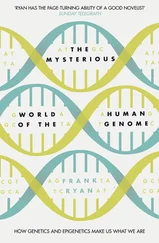Humans do not give birth to millions of eggs at a very early stage of embryological development, but rather to highly developed infants, which demands that they be nurtured for a very long period of time in the womb. For this purpose evolution has designed the human uterus as a single chamber, roughly the shape of an inverted pear, which is optimally designed for bearing a single foetus. The highest recorded number of living offspring born to a human mother in a single pregnancy is the eight babies born to an American mother in January 2009, all of whom lived. They were not conceived in the normal way but through assisted fertility treatment, and it is unlikely that all would have lived without the assistance of modern obstetric care. Indeed, obstetricians rightfully regard any increase above the normal single offspring as carrying an increased risk to both mother and offspring, even for twins.
Fitness, in human terms, is clearly more complex than we see in lobsters, but nevertheless the same basic non-Spencerian considerations apply, in terms of relative fitness.
The modern Darwinian concept of natural selection is brutally simple and depends on a system of probability, amenable to calculus. Where an individual of any species acquires some slight advantage in terms of survival over its fellows, it is more likely to survive long enough to have offspring, and if the advantage is hereditary, the offspring in turn will enjoy the same advantage over their own generation, so the advantage in time becomes part of the evolving species. From the fitness point of view, the hereditary advantage gives the individual, and its offspring at every subsequent stage of reproduction, the chance of making a bigger contribution to the species gene pool than the average member of the species. It’s really that simple. We can see, from the Darwinian standpoint, that relative fitness is a way of measuring advantage from a natural selection point of view. In time, particularly if the affected group within a species is isolated, geographically or otherwise, from the remainder of the species, an accumulation of such hereditary changes – or a rapidly developing major change – will so alter the affected group that they are no longer capable, or likely, to reproduce with members of the original species. This is the perfectly reasonable Darwinian explanation of how new species arise in a linear-with-branching pattern from ancestral species.
The creation of new species from old is termed “speciation”. Spencer, who was influenced by the French evolutionary biologist, Lamarck, believed that evolution was driving all of life, and most particularly the human species, towards a higher, utopian, destiny. But it is clear that Darwin’s theory of evolution by means of natural selection embraces no such ideal. On the contrary, selection works through the biological necessities of survival and comparative success in reproduction, which have nothing to do with morality, and have no in-built drive towards a philosophic, or religious, ideal of individual or societal perfection.
The concept of natural selection, as proposed by Darwin, was both logical and amenable to experimental confirmation, so that, in spite of considerable opposition from both Church and rivals within his own field, it appealed to the majority of scientists, and eventually to the educated society of his day. However, it embodied a weakness of which Darwin himself was well aware. For selection to work, it demanded a source, or sources, of hereditary change, which would give rise to the key advantages in survival, and thus relative fitness, of one individual, or group, over the others of its own species. Today we know that this implies some sort of genetic, or genomic, innovation, but Darwin was hampered by the ignorance of the mechanisms of heredity in his day. The very concept of genetics was unknown and the enlightenment of DNA would be unavailable until almost a century after publication of The Origin of Species . What Darwin achieved, given the science of his day, was, without exaggeration, world-changing. We cannot criticise him if he was obliged to fall back on now-outmoded concepts of parental mixing, or blending, as if the quaint notion of pedigree could somehow supply what we now realise to be the vast genetic and genomic change necessary to give rise to biodiversity. It was an inherent weakness in his theory that was unlikely to go away.
Thus it was not altogether surprising that, at Oxford, in 1894, during his presidential address to the British Association for the Advancement of Science, the Marquis of Salisbury attacked the concept of natural selection. The distinguished Thomas Henry Huxley was in the audience – cast by his critics as Darwin’s bulldog – but in reality one of the most objective, and formidable, biologists of his day. Huxley was faced with the fact that, where many earlier critics had attacked Darwinism from a religious perspective, adopting the Procrustean stance of faith, Salisbury was a highly educated man, an ex-Prime Minister and amateur scientist, and his attack was based in logic. He did not doubt the reality of evolution and he praised Darwin for convincing science, and the more educated levels of society, of this – rather, it was Darwin’s mechanism of evolution, natural selection, on which he focused his criticism. To date no scientist had ever proved in scientific experiment or observation that natural selection could produce a new species from an ancestral one. Moreover, Darwin’s theory assumed a very slow and gradual change in the evolution of life, and biodiversity, implying that the history of the Earth extended, say, to something like a billion years. Meanwhile Lord Kelvin, widely regarded as the foremost physicist in the world, had calculated the presumed age of the Earth from the physics of a cooling body, and pronounced that it could be no more than a million years old – too little time for life’s diversity to have evolved.
Although Huxley defended Darwin as best he could, he was hampered by the prevailing lack of hard evidence, and so inevitably he lost the battle to the scientific methodology of Kelvin. Darwinism had fallen to its lowest point, a nadir that would subsequently be recalled by Huxley’s own grandson, Julian, as “the eclipse of Darwinism”. Indeed, Julian Huxley would go on to describe the pressures on Darwinism that arose about the end of the nineteenth century and extended into the twentieth, when they were compounded by the growing dichotomy of many of the core disciplines of the biological sciences. In a great series of scientific publications, author after author would simply assume that their observations implied evolutionary adaptations, and thus the influence of natural selection, with ‘little contact of [such] evolutionary speculation with the concrete facts of cytology and heredity, or with actual experimentation’. The new generation of selectionists ignored the rising field of genetics, as pioneered by the writings of the Bavarian monk, Gregor Mendel, and they ignored the discovery of mutation by the Dutch botanist, Hugo de Vries. Evolutionary biology fragmented into three different factions – the selectionists, who had an undying conviction in natural selection, Mendelians (what we would now call geneticists), and mutationists, inspired by de Vries – and for several decades the discord continued.
In the opening chapters of his book, Evolution: The Modern Synthesis , Julian Huxley put his finger on the heart of the problem: ‘The really important criticisms have fallen upon Natural Selection as an evolutionary principle and centred round the nature of inheritable variation.’ 3
Today we know that Lord Kelvin was wrong and the Earth is far older even than Darwin conjectured, at roughly 4.6 billion years old, with life beginning at a very early stage in the planetary evolution and thus giving plenty of time for the evolution of biodiversity. Kelvin was ignorant of the radiation at the core of the Earth, which has kept the planet much warmer than would be predicted for an otherwise cooling body. Moreover, Huxley’s book, in its very title, indicates how the raging conflicts of this early phase of evolutionary biology were resolved. It may seem ironic, if perhaps predictable, that they were resolved through a synthesis of the three rival concepts: natural selection, the growing understanding of Mendelian genetics, and the potential of mutation to give rise to the much-needed genetic variation that, when it affected the germ cells, such as the sperm or the ovum, was inevitably hereditary. The consummation of all three forces gave rise to the synthesis theory of modern Darwinism. But this, as Huxley made clear, also implied important differences from the perspective originally adopted by Darwin himself.
Читать дальше












